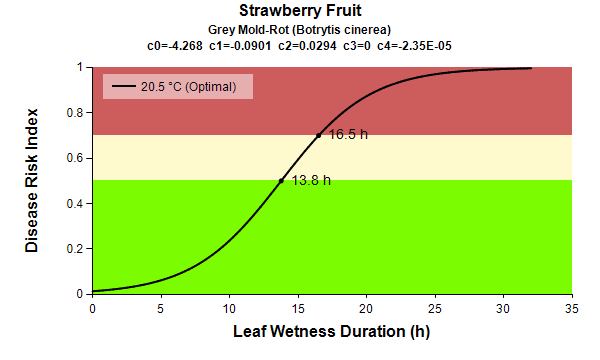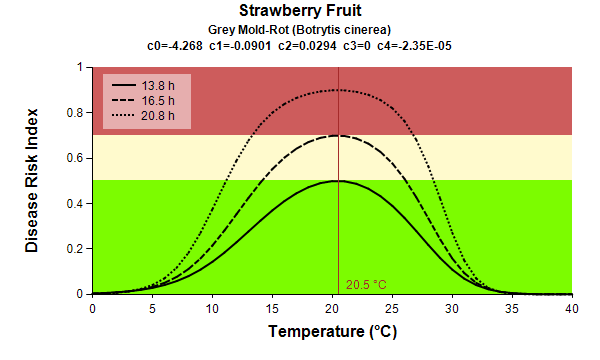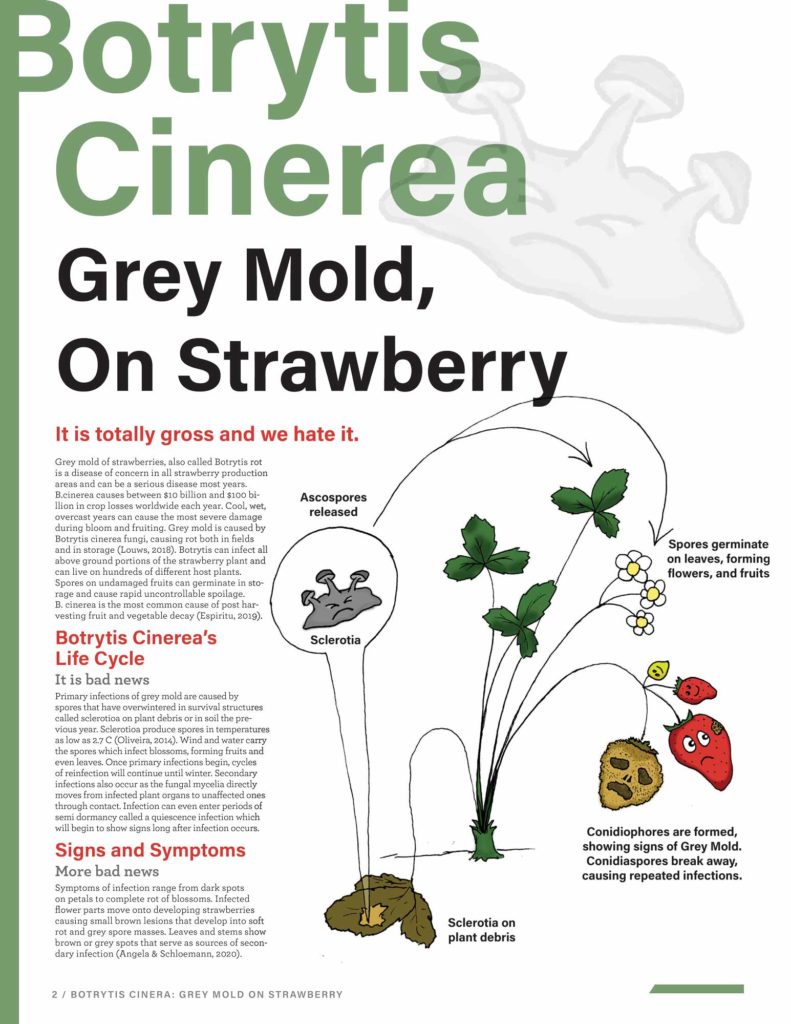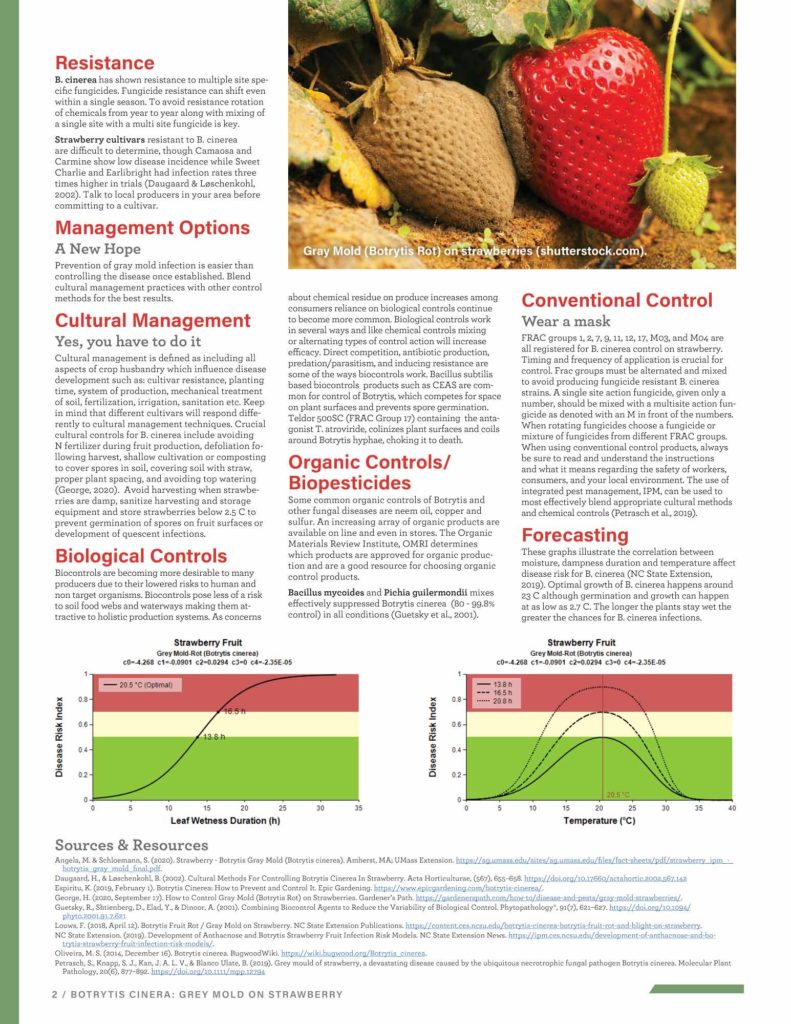Grey mold of strawberries, also called Botrytis rot is a disease of concern in all strawberry production areas and can be a serious disease most years. B.cinerea causes between $10 billion and $100 billion in crop losses worldwide each year. Cool, wet, overcast years can cause the most severe damage during bloom and fruiting. Grey mold is caused by Botrytis cinerea fungi, causing rot both in fields and in storage (Louws, 2018). Botrytis can infect all above ground portions of the strawberry plant and can live on hundreds of different host plants. Spores on undamaged fruits can germinate in storage and cause rapid uncontrollable spoilage. B. cinerea is the most common cause of post harvesting fruit and vegetable decay (Espiritu, 2019).
Botrytis Cinerea’s Life Cycle
It is bad news
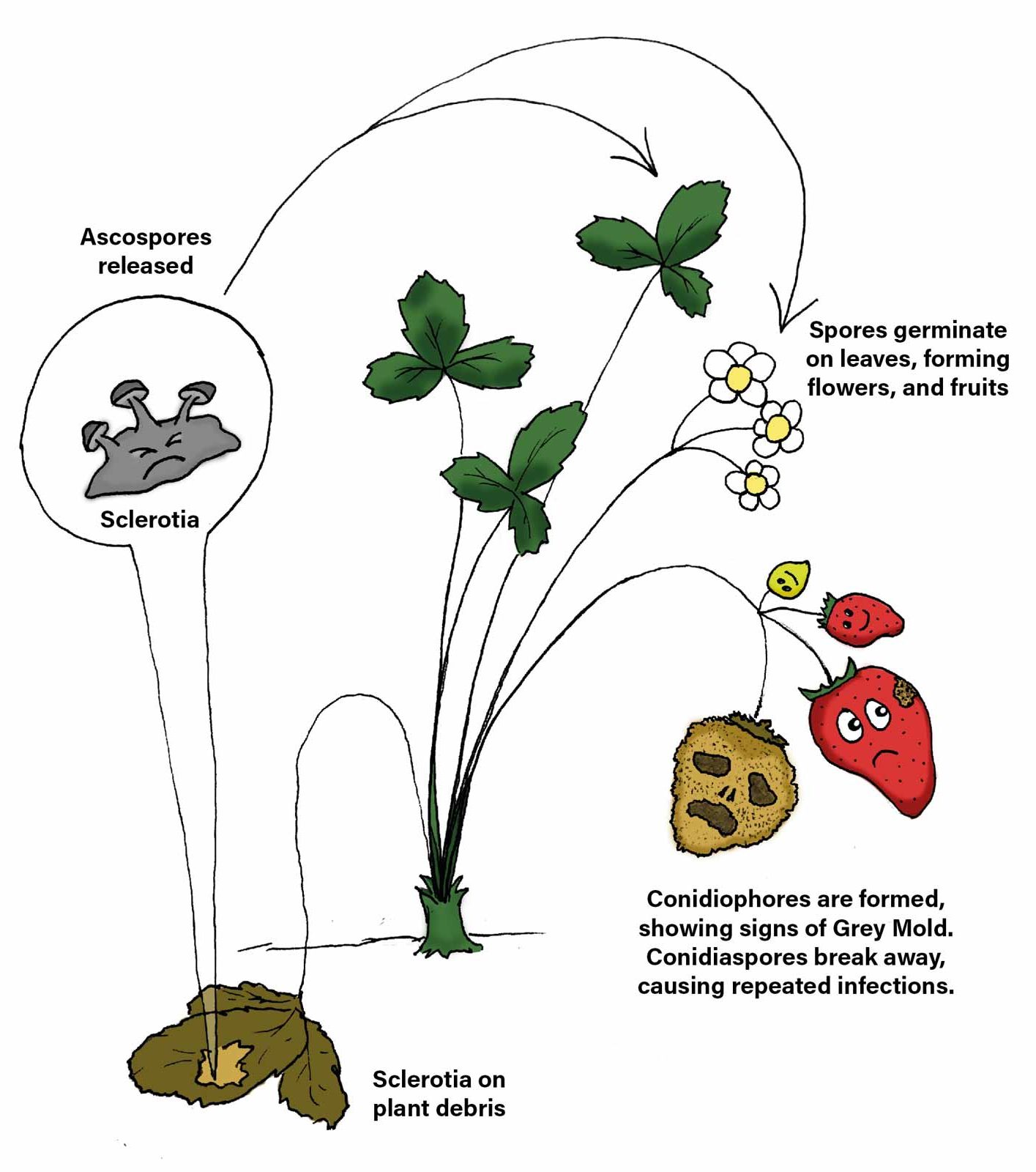
Primary infections of grey mold are caused by spores that have overwintered in survival structures called sclerotioa on plant debris or in soil the previous year. Sclerotioa produce spores in temperatures as low as 2.7 C (Oliveira, 2014). Wind and water carry the spores which infect blossoms, forming fruits and even leaves. Once primary infections begin, cycles of reinfection will continue until winter. Secondary infections also occur as the fungal mycelia directly moves from infected plant organs to unaffected ones through contact. Infection can even enter periods of semi dormancy called a quiescence infection which will begin to show signs long after infection occurs.
Signs and Symptoms
More bad news
Symptoms of infection range from dark spots on petals to complete rot of blossoms. Infected flower parts move onto developing strawberries causing small brown lesions that develop into soft rot and grey spore masses. Leaves and stems show brown or grey spots that serve as sources of secondary infection (Angela & Schloemann, 2020).
Resistance
B. cinerea has shown resistance to multiple site specific fungicides. Fungicide resistance can shift even within a single season. To avoid resistance rotation of chemicals from year to year along with mixing of a single site with a multi site fungicide is key.
Strawberry cultivars resistant to B. cinerea are difficult to determine, though Camaosa and Carmine show low disease incidence while Sweet Charlie and Earlibright had infection rates three times higher in trials (Daugaard & Løschenkohl, 2002). Talk to local producers in your area before committing to a cultivar.
Management Options
A New Hope
Prevention of gray mold infection is easier than controlling the disease once established. Blend cultural management practices with other control methods for the best results.
Cultural Management
Yes, you have to do it
Cultural management is defined as including all aspects of crop husbandry which influence disease development such as: cultivar resistance, planting time, system of production, mechanical treatment of soil, fertilization, irrigation, sanitation etc. Keep in mind that different cultivars will respond differently to cultural management techniques. Crucial cultural controls for B. cinerea include avoiding N fertilizer during fruit production, defoliation following harvest, shallow cultivation or composting to cover spores in soil, covering soil with straw, proper plant spacing, and avoiding top watering (George, 2020). Avoid harvesting when strawberries are damp, sanitize harvesting and storage equipment and store strawberries below 2.5 C to prevent germination of spores on fruit surfaces or development of quescent infections.
Biological Controls
Biocontrols are becoming more desirable to many producers due to their lowered risks to human and non target organisms. Biocontrols pose less of a risk to soil food webs and waterways making them attractive to holistic production systems. As concerns about chemical residue on produce increases among consumers reliance on biological controls continue to become more common. Biological controls work in several ways and like chemical controls mixing or alternating types of control action will increase efficacy. Direct competition, antibiotic production, predation/parasitism, and inducing resistance are some of the ways biocontrols work. Bacillus subtilis based biocontrols products such as CEAS are common for control of Botrytis, which competes for space on plant surfaces and prevents spore germination. Teldor 500SC (FRAC Group 17) containing the antagonist T. atroviride, colinizes plant surfaces and coils around Botrytis hyphae, choking it to death.
Organic Controls/Biopesticides
Some common organic controls of Botrytis and other fungal diseases are neem oil, copper and sulfur. An increasing array of organic products are available on line and even in stores. The Organic Materials Review Institute, OMRI determines which products are approved for organic production and are a good resource for choosing organic control products.
Bacillus mycoides and Pichia guilermondii mixes effectively suppressed Botrytis cinerea (80 – 99.8% control) in all conditions (Guetsky et al., 2001)
Conventional Control
Wear a mask
FRAC groups 1, 2, 7, 9, 11, 12, 17, M03, and M04 are all registered for B. cinerea control on strawberry. Timing and frequency of application is crucial for control. Frac groups must be alternated and mixed to avoid producing fungicide resistant B. cinerea strains. A single site action fungicide, given only a number, should be mixed with a multisite action fungicide as denoted with an M in front of the numbers. When rotating fungicides choose a fungicide or mixture of fungicides from different FRAC groups. When using conventional control products, always be sure to read and understand the instructions and what it means regarding the safety of workers, consumers, and your local environment. The use of integrated pest management, IPM, can be used to most effectively blend appropriate cultural methods and chemical controls (Petrasch et al., 2019).
Forecasting
These graphs illustrate the correlation between moisture, dampness duration and temperature affect disease risk for B. cinerea (NC State Extension, 2019). Optimal growth of B. cinerea happens around 23 C although germination and growth can happen at as low as 2.7 C. The longer the plants stay wet the greater the chances for B. cinerea infections.
Sources & Resources
Angela, M. & Schloemann, S. (2020). Strawberry – Botrytis Gray Mold (Botrytis cinerea). Amherst, MA; UMass Extension. https://ag.umass.edu/sites/ag.umass.edu/files/fact-sheets/pdf/strawberry_ipm_-_ botrytis_gray_mold_final.pdf.
Daugaard, H., & Løschenkohl, B. (2002). Cultural Methods For Controlling Botrytis Cinerea In Strawberry. Acta Horticulturae, (567), 655–658. https://doi.org/10.17660/actahortic.2002.567.142
Espiritu, K. (2019, February 1). Botrytis Cinerea: How to Prevent and Control It. Epic Gardening. https://www.epicgardening.com/botrytis-cinerea/.
George, H. (2020, September 17). How to Control Gray Mold (Botrytis Rot) on Strawberries. Gardener’s Path. https://gardenerspath.com/how-to/disease-and-pests/gray-mold-strawberries/.
Guetsky, R., Shtienberg, D., Elad, Y., & Dinoor, A. (2001). Combining Biocontrol Agents to Reduce the Variability of Biological Control. Phytopathology®, 91(7), 621–627. https://doi.org/10.1094/ phyto.2001.91.7.621
Louws, F. (2018, April 12). Botrytis Fruit Rot / Gray Mold on Strawberry. NC State Extension Publications. https://content.ces.ncsu.edu/botrytis-cinerea-botrytis-fruit-rot-and-blight-on-strawberry.
NC State Extension. (2019). Development of Anthacnose and Botrytis Strawberry Fruit Infection Risk Models. NC State Extension News. https://ipm.ces.ncsu.edu/development-of-anthacnose-and-botrytis-strawberry-fruit-infection-risk-models/.
Oliveira, M. S. (2014, December 16). Botrytis cinerea. BugwoodWiki. https://wiki.bugwood.org/Botrytis_cinerea.
Petrasch, S., Knapp, S. J., Kan, J. A. L. V., & Blanco Ulate, B. (2019). Grey mould of strawberry, a devastating disease caused by the ubiquitous necrotrophic fungal pathogen Botrytis cinerea. Molecular Plant Pathology, 20(6), 877–892. https://doi.org/10.1111/mpp.12794
